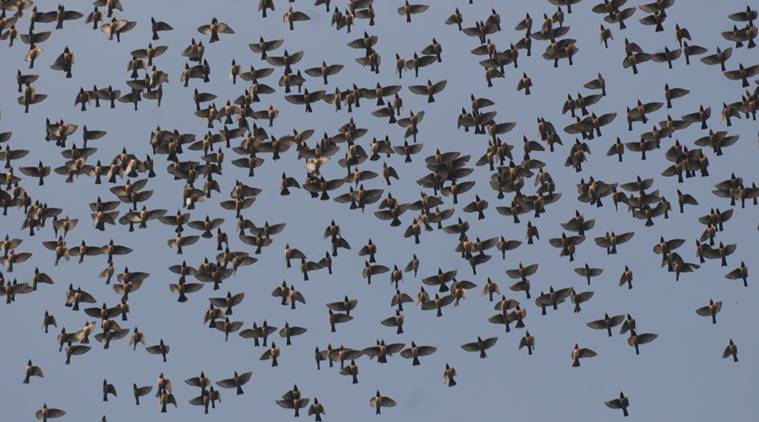Down in Jungleland: Circle of Life
The invisible soldiers who keep the rhythm of nature alive.
 Starlings are renowned for their “murmurations” — where huge flocks of them perform this massed synchronised flying ballet, weaving and banking like clouds of smoke (Source: Ranjit Lal)
Starlings are renowned for their “murmurations” — where huge flocks of them perform this massed synchronised flying ballet, weaving and banking like clouds of smoke (Source: Ranjit Lal)
Some days ago, when I stepped out on to my balcony at about four in the afternoon, I suddenly became aware of an incessant, fairly loud chorus of chittering coming from the trees in the cemetery next door. Gears whirred, pennies dropped and I thought, ‘Wow: the rosy starlings are back again!’ As I scanned the trees in the cemetery, I picked out a few of the birds hopping around, chattering away. In pale pink and black, they merged beautifully with the late afternoon light and shadows on the boughs and branches. Suddenly, the chatter stopped and I knew the birds must have taken flight. Starlings are renowned for their “murmurations” — where huge flocks of them perform this massed synchronised flying ballet, weaving and banking like clouds of smoke.
But what struck me yet again was that this sudden appearance of the birds was yet another indication that out there, there was a whole host of living creatures getting on with their lives; and, ensuring that the massive machinery of nature runs as smoothly and efficiently as possible, something we city dwellers, especially, are completely oblivious of, or just ignore as being not important enough. By the end of April, as suddenly as they appeared, the rosy starlings are gone, in keeping with their annual agenda. How many of us will have even registered their presence? These rosy starlings also festoon some of the trees in Delhi’s Connaught Place, but I wonder how many frenzied shoppers have noticed their presence.
Birds live their lives like clockwork. By February, you can hear the challenging cry of shikras in lightly wooded areas and parks, and know that a new generation has just been fledged. In early March, flocks of elfin-winged green bee-eaters skim high over the Delhi skies — and I have still to figure out why. Where have they come from and where are they going? (The same thing happens around September). As spring ends and summer begins, the barbets and coppersmiths go bananas with their competitive calling, and the magpie-robin is in full form, seeking out the highest posts in early mornings. Little purple sunbirds would have gone all Woodstock by now. By May, the koels (and common hawk-cuckoo) will have started getting hysterical — making the crows get their feathers all in a twist! The peacock, of course, swings his bejeweled tapestry this way and that, fans it out and zithers it seductively for the ladies (if only he had been blessed with a sweeter voice).
As the humidity grows, you might (if you do keep an ear out for such things) hear a joyous, ringing call from wooded parks and groves, and you know that the swashbuckling herald of the monsoon — the pied cuckoo — is back. It’s known to sail ahead of the monsoon winds all the way from Africa over the Arabian Sea to be here for a rambunctious romance. By October and November, the dumpy little spotted owlets would have started chattering querulously in groves and parks as they pick their partners for the forthcoming breeding season.
The appearance and disappearance of insects, too, tell us that there’s stuff happening backstage, as it were. At the first signs of warmth, the saffron-coloured wasps suddenly appear, hanging around keyholes and air-conditioner slats. In March, the gardens and parks are suddenly full of rotund ladybirds, trundling around like hippie Volkswagens and, by now, if the silk-cotton pods have burst, you’ll find pink and black cotton bugs mating frantically back to back amidst the silky tufts. As the rains draw in, the blade-blue spider wasps are everywhere, investigating holes of all kinds. They’ll stuff these holes with tiny anesthetised spiders, on one of which they will lay an egg so that their hideous grub has a larder full of fresh meat. Another mystery I still have to unravel is the sudden appearance of froglets — tiny black frogs — scampering hell for leather along the pathways of the Ridge, near the ponds. And, of course, the rains bring those Martians — the big red and black striped blister beetles, which have a thing for anything in mauve or yellow.
There is a whole pulsating world out there of which most of us city-dwellers are ignorant. The myriad creatures inhabiting it are the ones that are really calling the shots — maintaining nature’s gigantic engine and keeping it running smoothly, so that one year gives away seamlessly to the next. Of course, this natural rhythm is much easier to perceive in areas we don’t meddle in: un-molested forests, some wildlife preserves and even, to a lesser extent, in rural havens, hills and mountains. Which is, probably, also why the people who dwell in these places, and live in tune with this rhythm, are so much gentler, kinder, wiser, calmer and happier.
Ranjit Lal is an author, environmentalist and bird watcher.





- 01
- 02
- 03
- 04
- 05


























